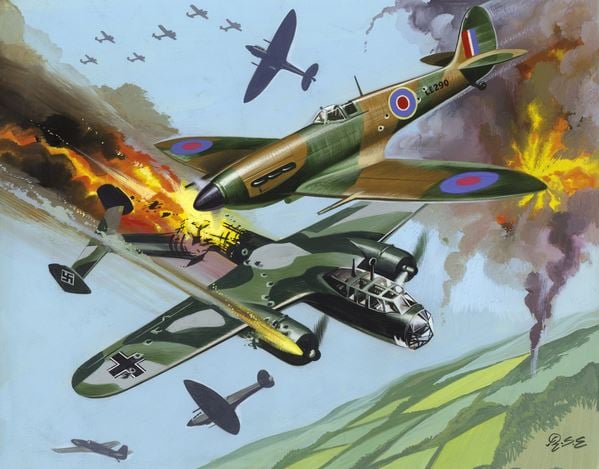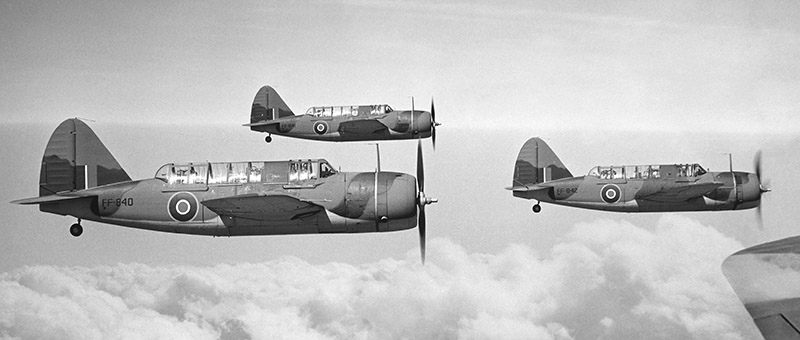
RAF’s 100 Year Anniversary: Celebration of Aviation!
The Royal Air Force is the world’s oldest independent air force, formed towards the end of WWI on 1st April 2018. It was to become the largest air force in the world, and has since played an invaluable role in British military history particularly during WWII and the Battle of Britain.
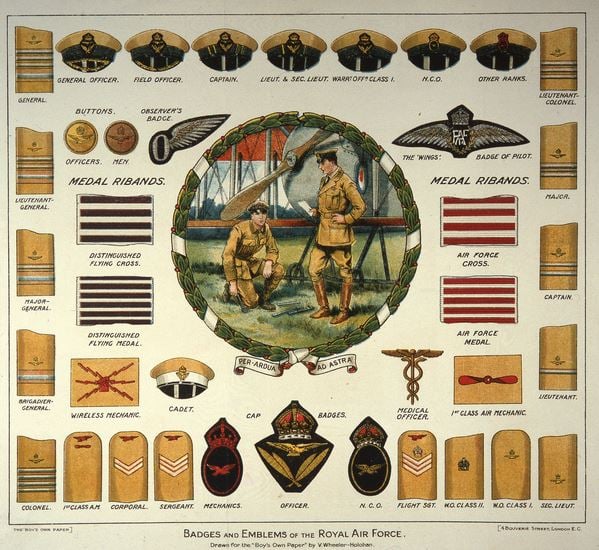
Badges of the Royal Air Force, which came into existence on 1st April 1918 , English School, (20th century) / Private Collection / Peter Newark Historical Pictures
The beginning
In April 1911, an air Battalion of the British army’s Royal Engineers was formed at Larkhill in Wiltshire – eight years after Wilbur and Orville Wright made the first flight of a self-propelled aircraft. In December 1911 the British navy formed the Royal Naval Flying School at Eastchurch, Kent. Both of these were absorbed into the Royal Flying Corps in May 1912, and a new flying school was created at Upavon, Wiltshire.
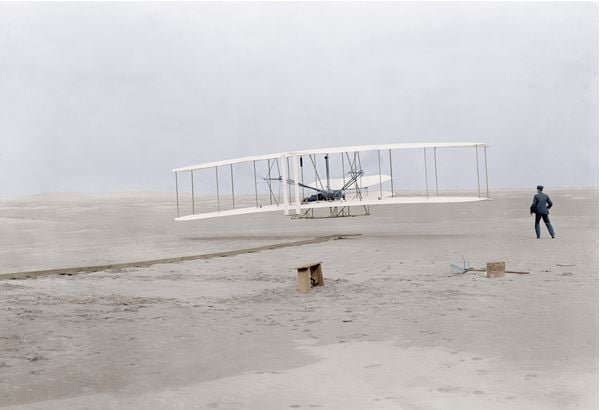
First flight of Orville Wright (1871-1948) at Kill Devil Hills, Kitty Hawk, North Carolina December 17, 1903, his brother Wilbur Wright stands on the right / PVDE
World War I and the formation of the RAF
In August 2014 (after a sequence of events) Britain declared war on Germany and World War I began. At the time Germany were a superior force in the air, with better strategies, greater technologies including the manual machine gun. England suffered greatly from devastating bomb raids, and the German flying aces – most famously Manfred von Richthofen aka the “Red Baron” – were winning battles in the sky. As a result there was a push to create a separate air ministry in order to compete with Germany. On April 1st 1918 the RAF was formed, joining together with the Women’s Royal Air Force.
The RAF described its mission as ‘… [to provide] an agile, adaptable and capable Air Force that, person for person, is second to none, and that makes a decisive air power contribution in support of the UK Defence Mission’. The mission statement is supported by the RAF’s definition of air power, which guides its strategy. Air power is defined as ‘the ability to project power from the air and space to influence the behaviour of people or the course of events’.
The first official missions of the RAF were carried out that day.
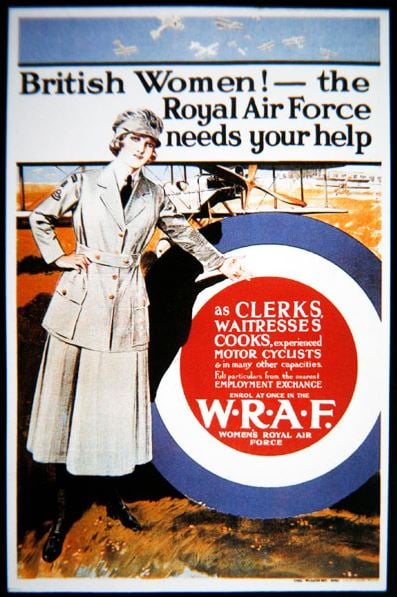
WWI British recruiting poster for the Women’s Royal Air Force, 1914-18, English School, (20th century) / Private Collection / Peter Newark Military Pictures
By the end of the war in November 1918, the RAF had gained the upper hand along the western front, with around 27,000 officers, 265,000 other ranks and more than 22,000 aircraft.
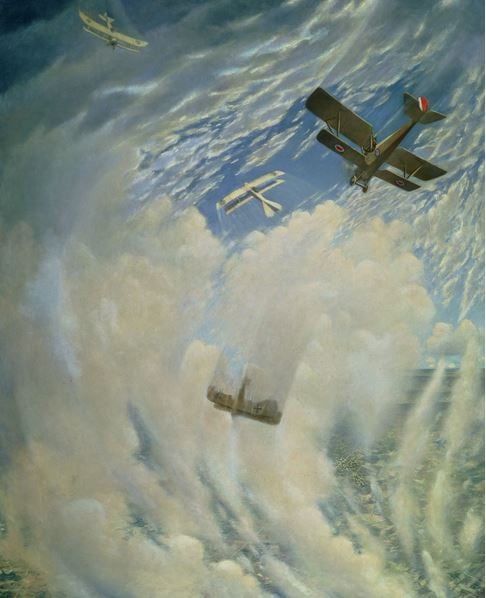
War in the Air, 1918 (oil on canvas), Christopher Richard Wynne Nevinson (1889-1946) / Canadian War Museum, Ottawa, Canada
World War II and the Battle of Britain
In June 1940, Adolf Hitler’s Germany was on the march through Europe, toppling Western democracies one after another. Britain was left on its own to tackle this onslaught. Adolf Hitler planned to invade Britain, and in July 1940 used the German air force Luftwaffe to destroy integral British ports in preparation. The RAF fliers – who were outnumbered by the German planes – put up fierce opposition in what became known as the Battle of Britain. Through radar technology, more maneuverable aircraft, and great bravery, the RAF pilots were able to keep the German invasion at bay. For every RAF plane shot down, two Luftwaffe warplanes were destroyed. The German invasion of Britain was delayed indefinitely, and in May 1941 the Battle of Britain came to an end.
Prime Minister Winston Churchill was moved to say of the RAF pilots during his famous wartime speech of August 1940: “Never in the field of human conflict was so much owed by so many to so few”.
The RAF today
Today the Royal Air Force maintains a fleet of various types of aircraft, which are cutting-edge in terms of technology. Most of their aircraft and personnel are based in the UK, with many others serving on operations (principally over Iraq and Syria) or at long-established overseas bases (Ascension Island, Cyprus, Gibraltar, and the Falkland Islands).
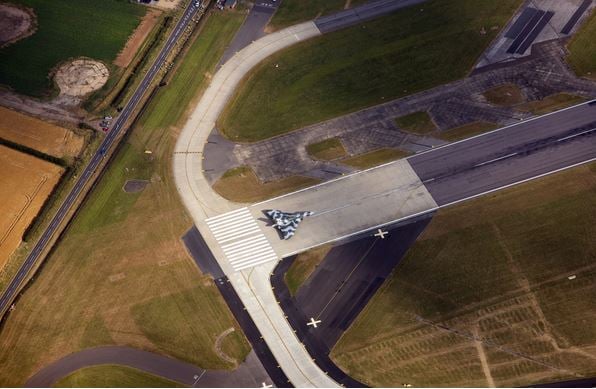
Last flying Vulcan bomber taking off from RAF Waddington, Lincolnshire. Photographed from the air in July 2009.
Find out more:
See footage of the Battle of Britain here
See images of the RAF here
Aviation blog posts:
Charles Lindbergh: Aviator extraordinaire
Buff Films: Call yourself a Film Buff?
Astronauts vs. Cosmonauts: the Great Space Race

